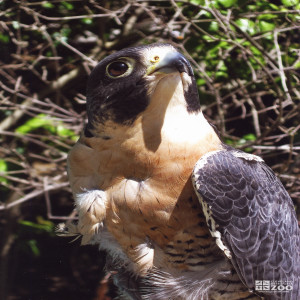Peregrine Falcon
[Falco peregrinus]
 Peregrine Falcons are one of the largest falcons in North America. They have long, pointed wings and a long tail. As with most raptor species the Peregrine Falcon males are smaller than females. Peregrine females are called Merlins and small males are called Gyrfalcons. Adults are blue gray at the top of their body with barred underparts. They have a dark head with thick sideburns. Juveniles are heavily marked, with vertical streaks instead of horizontal bars on the breast. Peregrine Falcons are one of the world's fastest birds and they can dive from vast heights to strike prey. They can reach speeds of up to 200 miles per hour. Peregrines are found on six continents though was seriously endangered in the mid-20th century because of the effects of DDT and other persistent pesticides
Peregrine Falcons are one of the largest falcons in North America. They have long, pointed wings and a long tail. As with most raptor species the Peregrine Falcon males are smaller than females. Peregrine females are called Merlins and small males are called Gyrfalcons. Adults are blue gray at the top of their body with barred underparts. They have a dark head with thick sideburns. Juveniles are heavily marked, with vertical streaks instead of horizontal bars on the breast. Peregrine Falcons are one of the world's fastest birds and they can dive from vast heights to strike prey. They can reach speeds of up to 200 miles per hour. Peregrines are found on six continents though was seriously endangered in the mid-20th century because of the effects of DDT and other persistent pesticides
Location: Animals Formerly at Zoo
Share:
Range
All continents except Antarctica
Habitat
Peregrine falcons inhabit seacoasts, mountains, rocky crags, and temperate forests.
Conservation Status
Least ConcernPrimary Threats
Gestation
Incubation: about 30 days
Litter
Clutch: usually three
Behavior
A fast, dashing flier, this falcon travels everywhere at a fast speed in a level, driving flight or in spectacular dives. They perch for long periods on ledges or trees, feeding on small to medium-sized birds, usually taken on the wing, then carried to a perch to be eaten. They often hunt in the early morning and late evening in dim light. They nest on bare ledges and on high cliffs and are often noisy in the nest area with harsh screams of “kak kak kak” and whines of “keer-ik keer-ik."
Reproduction
Peregrine falcon nests are made by scraping out a shallow cup on the shelf to hold the eggs. Sites are often re-used season after season, and pairs tend to frequent the nesting area for much of the year. They breed in early summer, the female laying her clutch of reddish-brown eggs during August or September. The sexes share the incubation duties, with the female doing the most. The eggs take about 30 days to hatch, and the nestling fledge in 35 to 42 days. At the time of hatching, the chicks are covered in dense white down, but this is soon replaced by the juvenile plumage.
Wild Diet
Small to medium-sized birds, small mammals
